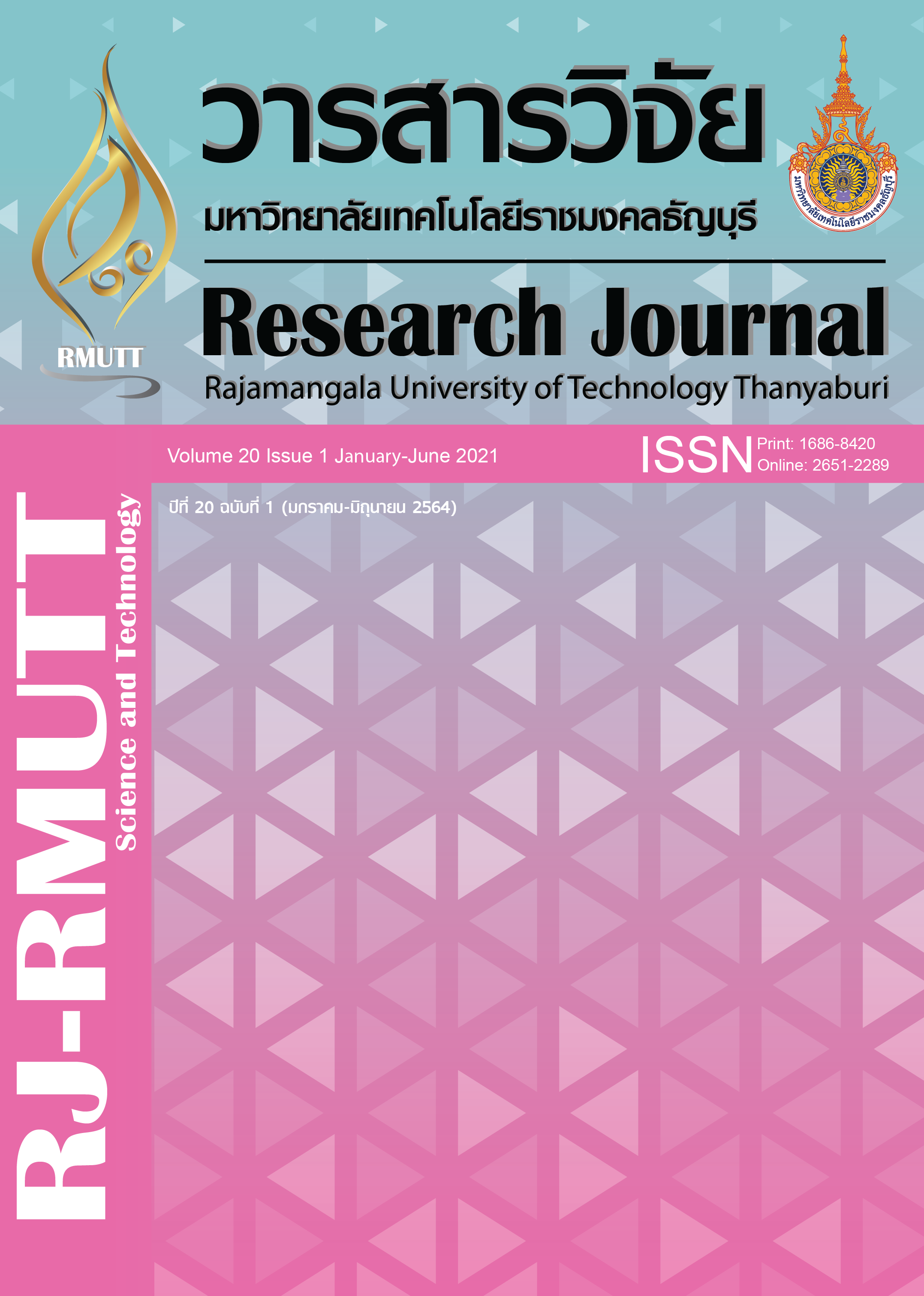Trend of Gunshot Residue Examination in Thailand
Main Article Content
Abstract
The objective of this research is trend analysis of gunshot residue examination in Thailand by referring to the comparison between the result of expert interview and both Thai and American research in the recent five years (2015 – 2019), All research is public for all access. All experts belong to police officers of Firearms and Ammunition Sub – Division of Central Police Forensic Science Division, Central. The questionnaire result showed that all 8 experts are graduated with bachelor's and higher bachelor degree. They have more than 5 years in Ballistic forensics experience. The interview is included activity details of gunshot residue analysis such as Type of gun, testing method and the material sample. The problem in their work, Applied the research in working and also the interesting study topic. The result of trends analysis of gunshot residue examination was shown in 3 categories 1. Trends of gunshot residue examination for practice 1.1. Strengthen the relationship between the related organization 1.2. Continually sourcing innovation of weapon information which could contribute to the characteristic of gunshot residue 1.3. organize document 2. Trends of gunshot residue examination for organization 2.1 Support officer in terms of training 2.2 Scholarship or observation study abroad 2.3. Increasing budget for scientific equipment for the provincial part 3. Trend of gunshot residue examination for the researchers shows by the interest topics, 1.) Interested topic and relate to recent research. 2.) Interested topic and new research. 3.) Interesting topic and could reference by American research, which could direct the future study and the result of this research would be an advantage to the near future.
Article Details

This work is licensed under a Creative Commons Attribution-NonCommercial-NoDerivatives 4.0 International License.
References
กองแผนงานอาชญากรรม สำนักงานยุทธศาสตร์ตำรวจ (ผอ.สยศ.ตร.). สถิติฐานความผิด คดีอาญา รายปี [อินเทอร์เน็ต]. 2561 [สืบค้นเมื่อวันที่ 14 ก.พ. 2563]. จาก: http://pitc.police.go.th/dirlist/dirlist.php?dir=/crimes
สำนักข่าวไทยรัฐ. ถล่ม5นัดดับ ส.จ.เมืองโอ่ง [อินเทอร์เน็ต]. 2558 [สืบค้นเมื่อวันที่ 14 ก.พ. 2563]. จาก: https://www.thairath.co.th/news/local/485424
ยุทธพงศ์ เศรษฐีสมบัติ, ศิริรัตน์ ชูสกุลเกรียง. การหาปริมาณไนเตรทและไนไตรท์ในเขม่าปืนที่ติดบนผิวรถยนต์โดยเทคนิคไออนโครมาโตกราฟี. วารสาร Veridian E Journal ฯ สาขาวิทยาศาสตร์และเทคโนโลยี. 2557;1(2):64-75.
Carter L. Gunning for firearms [อินเทอร์เน็ต]. 2562 [สืบค้นเมื่อวันที่ 14 ก.พ. 2563]. จาก: https://www.bangkokpost.com/thailand/special-reports/1691936/gunning-for-firearms.
Terry M, Fookes B, Bridge CM. Determining the effect of cartridge case coatings on GSR using post-fire priming cup residue. Forensic Sci Int. 2017;276:51-63.
Do SEM 24 hr. วิเคราะห์เขม่าดินปืน ด้วยเทคนิค SEM, EDS/EDX [อินเทอร์เน็ต]. 2557 [สืบค้นเมื่อวันที่ 15 พ.ค. 2563]. จาก: http://www.dosem24hr.com/index.php?lay=show&ac=article&Id=539649730&Ntype=8.
เบญจ์ พุฒินิล, ศุภชัย ศุภลักษณ์นารี. การวิเคราะห์หาปริมาณไนเตรทและไนไตร์ทในเขม่าดินปืนด้วยออนโครมาโทกราฟี. วารสาร Veridian E Journal ฯ สาขาวิทยาศาสตร์และเทคโนโลยี. 2555;5(2):730-41.
กุลยา วันจันทร์. การวิเคราะห์หาปริมาณไนไตรท์และไนเตรทในเขม่าดินปืนที่ติดบนมือและปลอกกระสุนปืนโดยเทคนิค ไอออนโครมาโทกราฟี [วิทยานิพนธ์ปริญญาบัณฑิต]. นครปฐม: มหาวิทยาลัยศิลปากร; 2560.
พัชรี เปรมกระโทก, วรรณฤดี ทองจุลกลาง, อารีรัตน์ ริมใหม่, ธนากร เปลื้องกลาง. การวิเคราะห์ปริมาณไนไตรท์และไนเตรทในตัวอย่างเขม่าที่เกิดจากการยิงปืนด้วย วิธีสเปกโตรโฟโตเมตรี. วารสารวิจัย วิทยาศาสตร์และเทคโนโลยี มหาวิทยาลัยราชภัฏนครราชสีมา. 2560;2(2):17-30.
พุทธิชาต มิ่งชะนิด, ณรงค์ กุลนิเทศ. การศึกษาระยะเวลาการคงอยู่ของปริมาณเขม่าดินปืนภายหลังการยิงปืน 9 มม. บนหลังมือและ ฝ่ามือ จำแนกตามช่วงเวลาหลังยิงปืนตามขนาดอาวุธปืนและลูกกระสุนปืน. วารสารวิจัย มหาวิทยาลัยขอนแก่น (ฉบับบัณฑิตศึกษา). 2560;17(3):8-18.
สุรีย์พร ตันติศักดิ์. ความสัมพันธ์ระหว่างปริมาณเขม่าปืนในโพรงจมูกผู้ยิงปืนกับระยะเวลาภายหลังการยิงที่วิเคราะห์ โดยเทคนิค Inductively coupled plasma optical emission spectrometry (ICP-OES) [วิทยานิพนธ์ปริญญาบัณฑิต]. กรุงเทพฯ: จุฬาลงกรณ์มหาวิทยาลัย; 2559.
คุณิตา อ่อนละออ, จิรวัชร ธนูรัตน์. การทดสอบประสิทธิภาพของสำลีก้านในการเก็บตัวอย่างเขม่าปืนชนิดอนินทรีย์. ใน: Full Papers NIGRC 2016. The national and international graduate research conference 2016; 15 ม.ค. 2559; อาคารพจน์ สารสิน มหาวิทยาลัยขอนแก่น ขอนแก่น. 2559. น. 166-74.
พุทธิชาต มิ่งชะนิด, ณรงค์ กุลนิเทศ. การศึกษาความสัมพันธ์ของปริมาณเขม่าปืนภายหลังการยิงปืนบนหลังมือและฝ่ามือ จำแนกตามอาชีพ ช่วงเวลาหลังยิงตามขนาดอาวุธปืนและลูกกระสุนปืน. ใน: บูรณาการงานวิจัยสู่การพัฒนาท้องถิ่นที่ยั่งยืน. สัมมนาวิชาการ เครือข่ายบัณฑิตศึกษา มหาวิทยาลัยราชภัฎภาคเหนือ ครั้งที่ 17; 21 ก.ค. 2560; ศูนย์วัฒนธรรมภาคเหนือตอนล่าง วังจันทน์ริเวอร์วิว มหาวิทยาลัยราชภัฏพิบูลสงคราม พิษณุโลก; 2560. น. 2579-92.
Bell S, Seitzinger L. From binary presumptive assays to probabilistic assessments: Differentiation of shooters from non-shooters using IMS, OGSR, neural networks and likelihood ratios. Forensic Sci Int. 2016; 263:176-85.
พลอยไพลิน แก้วบุญเรือง. รูปแบบการกระจายตัวของเขม่าปืนแบบอินทรีย์บนมือภายหลังการยิงปืน. ใน: Full Papers NIGRC 2016. The national and international graduate research conference 2016; 15 ม.ค. 2559; อาคารพจน์ สารสิน มหาวิทยาลัยขอนแก่น. ขอนแก่น: 2559. น. 175-82.
Black O, Cody R, Edwards D, Cizdziel JV. Identification of polymers and organic gunshot residue in evidence from 3D-printed firearms using DART-mass spectrometry. Forensic Chem. 2017;(5):26-32.


